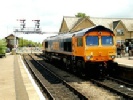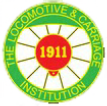Archive Section




© Text by John Lunn, Photo by Peter Knottley

Peter Knottley's photo of Waterloo Depot was taken a few months prior to the tunnel walk during the Locomotive & Carriage Institution's Waterloo & City Line Seminar and Depot visit on 14th March 1998. Note the units are still in Network SouthEast livery.
The Waterloo and City line tunnel walk originally planned for June, 1998 took place a few weeks early, on a Sunday in May.
The members and our guide, Ron Carter Leahy, the L.T. Duty Manager, met on the Waterloo main line concourse at 10:00 and proceeded to Ron's office at 10:15. Before proceeding into the tunnels, Ron gave us a safety talk and mentioned a few items about the tunnels.
Prior to the start of the walk, we took time to look around the building, which once housed the Waterloo and City lines generating station. It is difficult to work out how the generating station had been laid out, as it would appear that the floor, which may have carried the boilers, had been removed.
Entering the tunnel via the depot / sidings at the Waterloo end of the line gave us the opportunity to see the stock, which is still in Network South East livery and the workshops, in which all day-
Walking past the fully illuminated but deserted platform, we entered the Waterloo -
Proceeding into the tunnel, all light from the Waterloo platform was lost and we now had to rely on the tunnel lights and hand lamps. This stage of the walk was easy and quite comfortable as we were going downhill.
Signalling is minimal, with just an intermediate signal breaking up the mile and a bit of track. This is placed approximately half way through the tunnel and consists of distant and stop signals.
At the lowest point under the River Thames there is a cross passage between the two running tunnels and a sump, which takes away any water seeping in from the Thames. Despite the two running tunnels passing under the Thames, there is very little leakage; the sump itself appeared to be quite shallow.
Proceeding on towards Bank station, we now started uphill and the walking became distinctly harder. By the time we arrived at the crossovers outside Bank station we had all become quite warm and thirsty. Before having a rest however, we proceeded along the illuminated Bank station platform to the travellator. We then walked up this towards the booking hall, all the time admiring the murals now gracing both walls along the length of the travellator.
Returning to the Waterloo or up platform, we took a well earned rest and drinks of orange juice (a large bottle of which had been carried by Ron) sitting in a unit berthed in the platform.
Returning through the Waterloo direction tube, it was noted that the scenery on offer was generally similar to that in the Bank direction tube, though there is no sump on this side.
Ron pointed out that when under the river, ships' engines could be heard passing overhead. I was somewhat sceptical about this, but then, as if to prove a point, a ship obligingly passed overhead; its engine and the sound of water being disturbed was very clear. Some idea was gained as to what it must be like in a submarine; we waited for the depth charge but none came!
On our return to Waterloo, time was taken for a few photographs to be taken and returning to Ron's office, borrowed yellow vests were handed back. Tea, coffee and biscuits were on offer to satisfy the inner man.
After thanking Ron Carter Leahy, we returned to the surface and daylight.